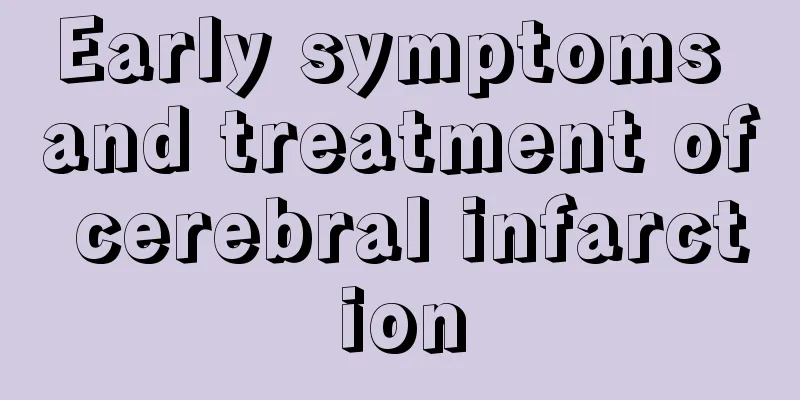Early symptoms and treatment of cerebral infarction

|
The brain is the most important part of the human body because it controls the body's limbs, language, and behavioral abilities, all of which need to be controlled by the brain. If the brain has serious symptoms of disease, it needs to be examined and treated in a timely manner. Cerebral infarction is a common disease, and its symptoms are more common among the elderly. Because the elderly are older, their blood circulation is slower and more prone to blockage. What are the early symptoms and treatments of cerebral infarction? When cerebral infarction occurs, people are often caught off guard. In fact, there are certain symptoms before the onset of cerebral infarction, which are what we call early symptoms. Understanding the early symptoms of cerebral infarction is of great significance for the early prevention and treatment of cerebral infarction Cerebral infarction is a cerebrovascular disease with neurological dysfunction. It is extremely harmful and has seriously affected people's normal lives. Preventing cerebral infarction is the first priority for people What are the early symptoms of cerebral infarction? 1. Blurred vision: manifested as temporary visual impairment or visual field loss, which usually recovers on its own within 1 hour. Coty performed fundus examination and cerebral blood flow measurement on 10 patients with transient visual impairment and found that 3 of them had retinal artery occlusion and 7 had branch retinal artery occlusion. 2. Hemiplegia: also known as transient ischemic attack. Strictly speaking, this is the mildest type of stroke. According to follow-up observations, more than half of the people will suffer ischemic stroke 3 to 5 years after a transient ischemic attack. 3. Continuous yawning: When cerebral arteriosclerosis gradually worsens, the lumen becomes narrower and narrower, cerebral ischemia and hypoxia worsen, especially when the respiratory center is hypoxic, it will cause yawning reflex. Frequent yawning occurs in about 80% of people within 5 to 10 days before an ischemic stroke, and is an important warning sign. 4. Amaurosis fugax: The patient suddenly becomes dark in front of his eyes and cannot see anything. The condition recovers within a few seconds or minutes and is accompanied by nausea, vomiting, dizziness and impaired consciousness. Recently, Norwegian doctor Koti found carotid atherosclerotic lesions in 11 out of 18 patients with amaurosis fugax. |
<<: Symptoms of Raynaud's disease
>>: Early symptoms of female genital warts eczema
Recommend
What is the best food for liver cancer
What food is best for liver cancer? 1. Liver canc...
How to stop vomiting after chemotherapy
For most patients who undergo chemotherapy, chemo...
Lung cancer has metastasized in the late stage, how to treat it and live longer
When lung cancer metastasizes in the late stage, ...
Can patients with skin allergies get vaccinated?
Generally speaking, there are many causes of huma...
The difference between cold white skin and warm white skin
There are many characteristics of human skin, for...
What is the reason for high alanine aminotransferase and aspartate aminotransferase?
High alanine aminotransferase and aspartate amino...
What symptoms will appear during the incubation period of lung cancer? 3 symptoms of lung cancer during the incubation period
Hoarseness: Lung cancer metastasis compresses the...
What should I do if my tear ducts are blocked?
Tear duct obstruction Tear duct obstruction is a ...
Tips for meeting your mother-in-law for the first time
If your relationship develops to the point where ...
The difference between agar and gelatin
Agar is a jelly powder with good stability and co...
What kind of pillow core is good
Having a good pillow that suits you can help you ...
Drinking milkshakes can also adjust premenstrual syndrome
Women crave food before their period, so why not ...
What should you pay attention to in your diet for liver cancer? These liver diseases are easily misdiagnosed as liver cancer
China is a hard-hit area for liver cancer, and a ...
Central placenta previa
During pregnancy, every pregnant mother should go...
Is low pressure 53 normal?
Many people have low blood pressure. When our blo...









